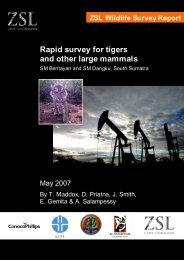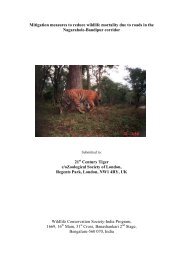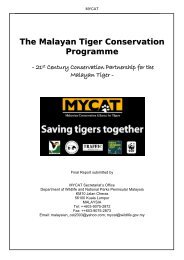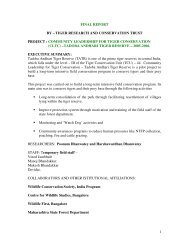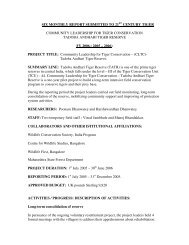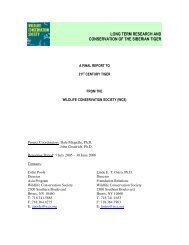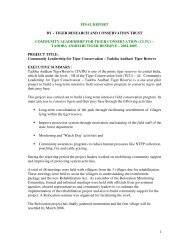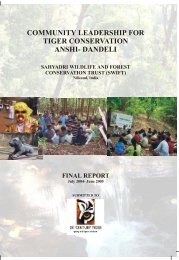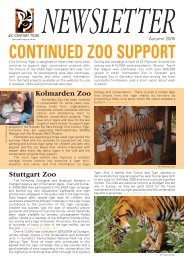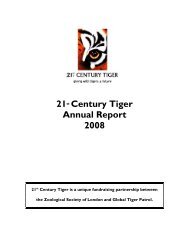The conservation of tigers and other wildlife in oil palm plantations
The conservation of tigers and other wildlife in oil palm plantations
The conservation of tigers and other wildlife in oil palm plantations
You also want an ePaper? Increase the reach of your titles
YUMPU automatically turns print PDFs into web optimized ePapers that Google loves.
survival (Western, 1989). Consequently, various priority sett<strong>in</strong>g exercises <strong>and</strong><br />
<strong>conservation</strong> predictions are based upon the assumption that most species only<br />
survive <strong>in</strong> ‘good’ habitat – areas with low or no human presence or high forest cover<br />
for example. However, <strong>in</strong> reality, the distribution <strong>of</strong> species between wilderness areas<br />
<strong>and</strong> human-dom<strong>in</strong>ated l<strong>and</strong>scapes is not clearly def<strong>in</strong>ed. Primary ra<strong>in</strong>forest, for<br />
example, <strong>of</strong>ten does not hold the highest densities <strong>of</strong> terrestrial species s<strong>in</strong>ce most <strong>of</strong><br />
the biomass is found <strong>in</strong> the canopy. Many species may prefer protected <strong>and</strong> therefore<br />
non-degraded habitat, but if necessary prove to be highly adaptable at surviv<strong>in</strong>g <strong>in</strong><br />
sub-optimal habitats outside protected areas. Evidence <strong>of</strong> survival is scarce, possibly<br />
because species coexist<strong>in</strong>g with humans or under <strong>in</strong>creased threat are far more<br />
secretive <strong>and</strong> therefore more difficult to detect (Maddox 2002), or simply because<br />
most research is focussed <strong>in</strong> areas where species survival is more obvious. However,<br />
persistent coexistence has been demonstrated between man <strong>and</strong> even the most<br />
unlikely <strong>of</strong> species outside protected areas (Maddox, 2002) <strong>and</strong> for some species,<br />
survival rates can even be better <strong>in</strong> unprotected areas. This can be true for smaller <strong>and</strong><br />
medium carnivores, for example wild dogs (Woodr<strong>of</strong>fe, G<strong>in</strong>sberg <strong>and</strong> Macdonald,<br />
1997) <strong>and</strong> cheetahs (Marker-Kraus <strong>and</strong> Kraus, 1994) which survive better outside coreprotected<br />
areas by avoid<strong>in</strong>g high densities <strong>of</strong> their predators (Creel, 1996). Other<br />
species, such as large, wide rang<strong>in</strong>g carnivores, may survive better <strong>in</strong> protected areas<br />
but due to the limitations on protected area size, exist<strong>in</strong>g protected areas are simply<br />
too small to encompass viable populations. For example, a <strong>conservation</strong> plan for<br />
grizzly bears <strong>in</strong> the state <strong>of</strong> Idaho <strong>in</strong> the United States showed that 34% <strong>of</strong> the state<br />
was required for a viable population (Shaffer, 1992, quoted <strong>in</strong> (Noss et al., 1996). Such<br />
a large proportion <strong>of</strong> l<strong>and</strong> could never be dedicated solely to <strong>conservation</strong>, thereby<br />
necessitat<strong>in</strong>g work outside protected areas to allow species survival.<br />
<strong>The</strong> importance <strong>of</strong> <strong>in</strong>dustrial l<strong>and</strong>scapes<br />
Whilst the importance <strong>of</strong> local communities <strong>and</strong><br />
their l<strong>and</strong> <strong>in</strong> <strong>conservation</strong> is well established <strong>in</strong><br />
<strong>conservation</strong> theory, the importance <strong>of</strong> <strong>in</strong>dustrial<br />
l<strong>and</strong>scapes is <strong>of</strong>ten overlooked, beyond their role<br />
<strong>in</strong> environmental damage. However, these<br />
l<strong>and</strong>scapes must be considered for several<br />
important reasons. Firstly, the very fact that<br />
<strong>in</strong>dustrial concessions can be a source <strong>of</strong><br />
environmental damage is reason <strong>in</strong> itself for<br />
engagement, <strong>in</strong> an effort to reduce it. This<br />
damage can either be direct, a consequence <strong>of</strong><br />
activities carried out on site e.g. pollution or<br />
hunt<strong>in</strong>g; or <strong>in</strong>direct e.g. due to habitat loss or<br />
disturbance. <strong>The</strong> <strong>in</strong>direct effects <strong>in</strong> particular are<br />
thought to be key factors <strong>in</strong> the decl<strong>in</strong>e <strong>of</strong> various<br />
species. Second, <strong>in</strong>dustrial l<strong>and</strong> is usually located<br />
<strong>in</strong> the most productive areas, for example most<br />
<strong>in</strong>dustrial l<strong>and</strong> <strong>in</strong> Sumatra is <strong>in</strong> areas that are or<br />
were lowl<strong>and</strong> tropical forest, which <strong>in</strong>creases the<br />
negative impacts <strong>and</strong> hence also <strong>in</strong>creases the<br />
importance <strong>of</strong> address<strong>in</strong>g these impacts. Thirdly,<br />
areas under <strong>in</strong>dustrial management are <strong>of</strong>ten<br />
under the control <strong>of</strong> a small number <strong>of</strong> people. This has the crucial advantage that if a<br />
decision is made, change can be implemented relatively quickly, easily <strong>and</strong> <strong>in</strong> an<br />
enforceable manner, <strong>in</strong> contrast to communal l<strong>and</strong>s that require a consensus to reach<br />
a decision <strong>and</strong> <strong>of</strong>ten lack the resources to enforce it once made. Fourthly, pressure is<br />
<strong>in</strong>creas<strong>in</strong>g on companies to implement change as consumers around the world<br />
become more <strong>and</strong> more aware <strong>of</strong> the importance <strong>of</strong> environmental problems <strong>and</strong> their<br />
own ability to change th<strong>in</strong>gs. Environmental issues, such as global warm<strong>in</strong>g, have<br />
rapidly moved from a marg<strong>in</strong>al position to central determ<strong>in</strong>ants <strong>of</strong> company policy,<br />
<strong>and</strong> biodiversity <strong>conservation</strong> issues are mov<strong>in</strong>g the same way (F&C Asset<br />
Management Ltd, 2004). Movements with<strong>in</strong> the forestry sector towards susta<strong>in</strong>able<br />
10 Wildlife <strong>conservation</strong> <strong>in</strong> <strong>oil</strong> <strong>palm</strong> <strong>plantations</strong>




